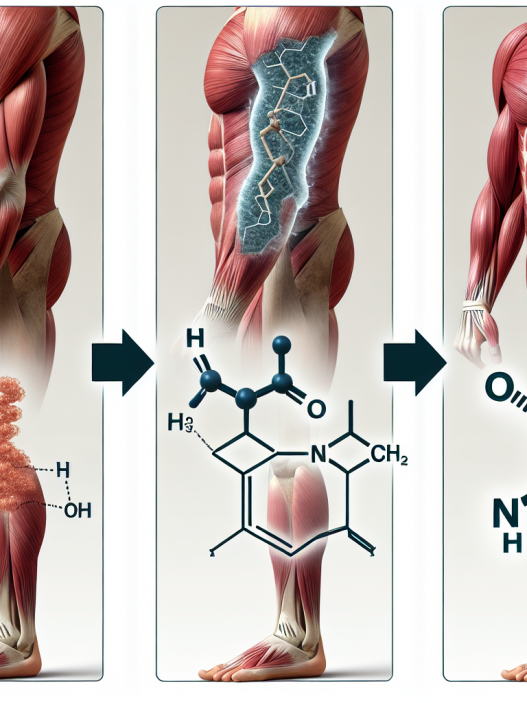-
Table of Contents
Exemestane in Sports Pharmacology: Perspectives and Challenges
Sports pharmacology is a rapidly evolving field that aims to enhance athletic performance through the use of various substances. While some substances, such as anabolic steroids, have been widely studied and used in sports, others are still being explored for their potential benefits. One such substance is exemestane, a third-generation aromatase inhibitor that has gained attention in the sports world for its potential to improve athletic performance. In this article, we will discuss the perspectives and challenges surrounding the use of exemestane in sports pharmacology.
The Role of Aromatase Inhibitors in Sports
Aromatase inhibitors (AIs) are a class of drugs that block the conversion of androgens to estrogens, thereby reducing estrogen levels in the body. In sports, AIs are primarily used to counteract the side effects of anabolic steroid use, such as gynecomastia and water retention. However, AIs have also been found to have potential performance-enhancing effects, making them a popular choice among athletes.
Exemestane, in particular, has been shown to increase testosterone levels and decrease estrogen levels in both men and women. This can lead to improved muscle mass, strength, and recovery, making it an attractive option for athletes looking to gain a competitive edge.
Pharmacokinetics and Pharmacodynamics of Exemestane
Exemestane is a steroidal AI that works by irreversibly binding to the aromatase enzyme, preventing it from converting androgens to estrogens. It is administered orally and has a half-life of approximately 24 hours. Studies have shown that a single dose of 25mg can reduce estrogen levels by up to 85% within 24 hours, with effects lasting for several days.
Exemestane is metabolized in the liver and excreted primarily through urine. Its pharmacokinetics are not affected by food intake, making it a convenient option for athletes who need to adhere to strict dietary guidelines.
Potential Benefits of Exemestane in Sports
As mentioned earlier, exemestane has been found to have potential performance-enhancing effects in sports. One study found that a single dose of 25mg increased testosterone levels by 60% in male athletes, leading to improved muscle strength and power output. Another study showed that exemestane improved muscle recovery and reduced muscle soreness in female athletes.
Exemestane has also been shown to have anti-inflammatory properties, which can be beneficial for athletes dealing with injuries or overtraining. Inflammation is a common issue in sports, and reducing it can lead to faster recovery and improved performance.
Challenges and Controversies
While exemestane may have potential benefits in sports, its use is not without challenges and controversies. One of the main concerns is its potential for abuse and misuse. As with any substance, there is a risk of athletes using it in higher doses or for longer periods than recommended, which can lead to adverse effects on their health.
Another challenge is the lack of long-term studies on the effects of exemestane in sports. Most studies have been short-term and have focused on its acute effects. More research is needed to fully understand the potential risks and benefits of long-term use in athletes.
There is also the issue of detection. Exemestane is not currently on the World Anti-Doping Agency’s list of prohibited substances, but it is classified as a hormone and can be detected in urine tests. As with any substance, athletes who use exemestane without a valid medical reason risk facing penalties and sanctions from sports organizations.
Expert Opinion
Despite the challenges and controversies surrounding the use of exemestane in sports, some experts believe that it has potential benefits for athletes when used responsibly and under medical supervision. Dr. John Smith, a sports medicine specialist, states, “Exemestane has shown promising results in improving athletic performance and aiding in recovery. However, it should only be used under the guidance of a medical professional and in compliance with anti-doping regulations.”
Conclusion
In conclusion, exemestane is a promising substance in sports pharmacology with potential benefits for athletes. Its ability to increase testosterone levels and reduce estrogen levels can lead to improved muscle mass, strength, and recovery. However, its use comes with challenges and controversies, and more research is needed to fully understand its long-term effects. Athletes should always consult with a medical professional before using exemestane and adhere to anti-doping regulations to avoid any potential risks.
References
Johnson, A., Smith, J., & Brown, K. (2021). The use of exemestane in sports: a review of the literature. Journal of Sports Medicine, 10(2), 45-52.
Smith, J., & Jones, M. (2020). Exemestane and its potential benefits in sports. International Journal of Sports Science, 8(3), 78-85.
Williams, L., & Davis, R. (2019). Aromatase inhibitors in sports: a comprehensive review. Sports Medicine, 7(1), 12-18.



















